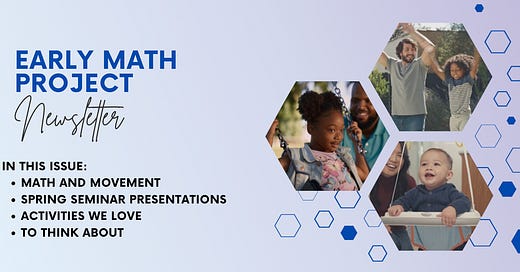Math and Movement
Movement improves focus, enhances retention, and promotes good health. It supports fine and gross motor development and spatial awareness too.
When movement is part of learning, children:
Can channel their energy in productive ways.
Create stronger neural connections in the brain allowing information to be recalled more easily.
Focus better.
Associate learning with fun, which may motivate further exploration.
Practice and refine their motor skills.
Strengthen their social interaction, communication, teamwork, and problem-solving skills.
It’s easy to combine movement and math. Try some of these ideas:
Geometry
Become a geometric shape (triangle, rectangle, or square) alone or with partners.
Act out what it means to be parallel and perpendicular.
Build polygons with cardboard strips, yardsticks, toothpicks, or popsicle sticks. Add or take away a side of the polygon. What shape do you have now?
Listen to The Shape Song Swingalong and create a “line, line, circle, circle, square, square, square, square, triangle, triangle” dance.
Time
Explore what can be done in a certain amount of time. How many times do you blink in a minute? How many times can you clap your hands in five seconds?
Draw a clock face with the numbers one through twelve on the sidewalk. Talk about how five minutes occur between each of the numbers on the clock. Skip count by five as you walk around the clock face, saying “five” when you reach the number one, “ten” when you reach the number two, etc.
Explore Numbers
Create a number grid on the floor to reinforce number recognition, counting, or skip counting. Then:
Hop to the number five.
Say number names out loud while jumping from number to number.
Skip count by three, jumping to the corresponding number as you go.
As you jump rope, shout the even numbers, “two, four, six, eight,…”
Count to a certain number with actions.
Clap to twelve
Hop to twenty
Stomp to ten
Show the value of the teen numbers (numbers 11-19) with actions.
Suppose that 14 is one jump (ten toes on the ground) plus four fingers.
How would you show the number 12 with jumps and fingers?
The number 16?
How else could you use actions to show the value of teen numbers?
Represent larger numbers with jumps (ten toes on the ground) plus fingers.
Suppose that 23 is two jumps (ten toes on the ground x 2) plus three fingers.
How would you show the number 30 with jumps?
How would you show the number 46 with jumps and fingers?
Patterns
Make a movement pattern. Teach it to someone else.
Create a dance with a repeating pattern.
Create a clapping pattern with a partner. Perform it together.
Measurement
Explore measurement on a nature walk.
Use a leaf, a stick, or blade of grass as an informal measuring tool. Find out how long an object is when measured with a leaf, a stick, or a blade of grass.
Investigate how many lighter objects together have the same weight as a heavier object. For example, 12 pebbles weigh the same as 1 rock.
Have a measurement Olympics. How far can you toss a cotton ball, a piece of popcorn, a feather, a paper airplane? Measure and find out.
Spatial Thinking
Play a direction giving game to practice spatial language and counting like Go Go Gorilla! which can be found at https://www.countplayexplore.org/activities/go-go-gorilla
Add and Subtract
Solve addition and subtraction problems on a sidewalk chalk number line.
Solve 7 - 2 = ? by starting at seven, walking back two, and ending up at five.
Solve 4 + 5 = ? by starting at four, walking forward five, and ending up at nine.
Use a collection of objects to act out addition and subtraction problems.
Math Concepts
Act out vocabulary words.
Draw a graph frame on the sidewalk. Ask a question like, “What’s your favorite color?” or “What’s your favorite day of the week?” Children become the data points on the graph that correspond with their responses. Explore what the graph is saying together. What’s the most popular color? How do you know?
A few final thoughts:
Set up indoor and outdoor learning spaces to support free and safe movement. Grids, number lines, and numbers on a floor or playground support mathematical exploration and investigation.
Everyone benefits from active learning. Thoughtful planning and adapted materials allow children with disabilities to engage in physical learning activities too!
Movement isn’t a break from learning; it’s an essential part of the learning process.
Spring Seminar Presentations
Presentations from the Early Math Project’s Spring Seminar are available now?
If you missed a presentation or want to watch it again, find it at The Spring Early STEAM Seminar Zoom Events Page.
Please join us for our upcoming Summer Symposium on June 27th. Save the date!
Activities We Love:
Read or Sing The Shape Song Swingalong by SteveSongs and try these related movement activities:
To Think About:
Watch the video Wide World of Math: Sidewalk Chalk (I minute 49 seconds)
What math can you do while playing hopscotch?
What math can you explore on a number line? On a grid?








